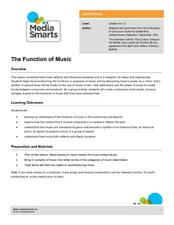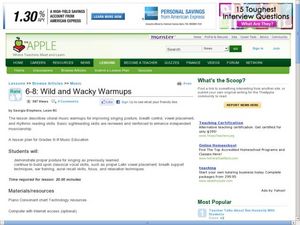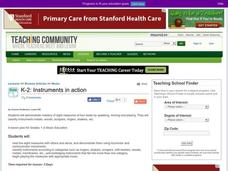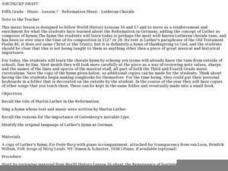Fun Music Company
Note Values
Note values are the focus of a short worksheet that asks young musicians to respond to short-answer questions and to complete a measure with notes of the appropriate value.
Curated OER
Music Notes
Students identify music notes. In this music notes lesson plan, students toss bean bags between partners the number of times of a note (quarter, half, dotted half, etc) value. Students also practice underhand tosses.
Curated OER
You've Got Rhythm
Young scholars study the rhythm value of a half note, quarter note, whole note, and eighth note. They stamp a rhythm pattern and create a clay animation which demonstrates note value.
Curated OER
The Function of Music
Explore concepts of audience, purpose and symbols in this lesson from Media Smarts that asks students to consider all the functions of music. Through a series of discussions and activities, your class will brainstorm possible functions...
Curated OER
Putting Pitch In Its Place
Students focus on reading musical notations. They see, hear, practice and write notations in the lessons to become more independent readers of music. They complete a Rubric for Pitch Worksheet.
Fun Music Company
Compound Time
To demonstrate their understanding of simple and compound time signatures, young musicians complete a chart by drawing quarter or dotted quarter notes equal in value to the note groups shown.
Curated OER
Wild and Wacky Warmups
Students explore vocal music techniques. In this vocal music lesson, students follow a series of warmup exercises modeled by the teacher, then participate in specific breathing and vocalizing exercises.
Curated OER
How Do I Measure Up? (Intermediate)
Fifth graders compare the relationship between meter in music and measurement in math. They practice sightreading music by determining the number of beats per measure, clapping and counting the rhythm.
Curated OER
Instruments In Action
Students read and demonstrate eight measures of four beats. In this music reading lesson, students read and demonstrate through movement their mastery of eight measures of four beats. Students also classify instruments.
Curated OER
SIGHT READING RHYTHM PATTERNS
The perception of rhythms by reading and the ability to auditorily discriminate these rhythm patterns by listening to them performed by the teacher is practiced here. your students will work to create an eight-beat long rhythm pattern.
Curated OER
A Round and A Round
Students practice singing rounds in daily warm-ups for 2 weeks prior to beginning this composition lesson. Students incorporate movement to the rhythm of each syllable, discuss syllables of words and their relationship to note values and...
Curated OER
Fifth Grade Music: Reformation Music, Lutheran Chorale
Fifth graders explore the chorale hymn by echoing a Lutheran chorale tune line by line. They examine the reasons for the importance of Gutenberg's movable type and the role of Martin Luther in the Reformation.
Curated OER
Meter Readers Turned Composers
Students compose eight measures of music after they practice interpreting time/signature meter.
Curated OER
West Side Story
In this music worksheet, middle schoolers examine the musical of West Side Story. They write parts of the musical while examining the musical score.
Curated OER
Using Numbers to Teach The Major Scale
Students study the numbers to the diatonic major scale using C note as a basis in this standards-based 45 minute instructional activity. Emphasis is placed on singing correct pitch, rhythmic accuracy, and proper breath control.
Curated OER
Introduction to Technologies in Music Education
Students identify and define a canon. Then, they create a canon in as many parts as they can and describe the various canons. Students also identify and interpret history of canons that includes their origins in Italy and France,...
Curated OER
Sight Reading Rhythm Patterns
Students demonstrate ability to sight read rhythms containing half, quarter and eighth notes and quarter rests; by clapping and chanting rhythms written on chart 1.
Curated OER
Original Band Compositions
Students create and perform original band compositions using their own band instruments. This two day lesson requires student compositions to be done at home. Students evaluate performances using a checklist for composing (included).
Music Education
Learning to Read Music: Types of Notes
Learn about the different types of notes in music--the whole note, half note, quarter notes, eighth note, and sixteenth note--and listen to midi files of music samples.
Other
Music Fundamentals
This is like a music theory textbook online. It includes great explanations and assignments, although there is not a way to check your completed assignments. It begins with the basics and goes through triads. Midi files are included.
Music Theory
Music theory.net
An online beginning music theory and ear training site. This site is for students to use at home to reinforce what they learn in class.
Music Education
Learning to Read Music: Basic Counting, Part 2
Beginning musicians can practice reading notes and counting beats using this resource that also provides several lines of music with different types of notes, rests, and time signatures.
Music Education
Learning to Read Music: Basic Counting
Apply basic knowledge of reading music by counting beats and reading notes. Here are some simple lines of music which incorporate different types of notes and patterns in common time.
























